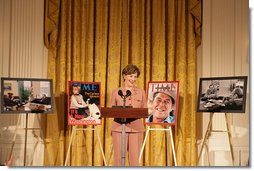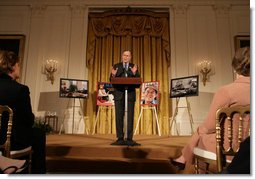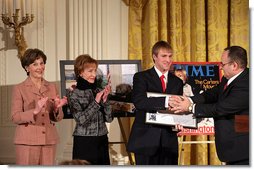|
Home >
News & Policies >
January 2007
|
For Immediate Release
Office of the First Lady
January 26, 2007
Mrs. Bush's Remarks at the Launch of the Hugh S. Sidey Scholarship for Print Journalism
East Room
The White House
2:39 P.M. EST
MRS. BUSH: Thank you all. Thanks, everybody. Thank you, and welcome, everyone, to the White House. I especially want to welcome Anne Sidey and all the members of the Sidey family, and of course, the members of my family, President George Bush and Barbara Bush. Welcome here. And to all the members of the White House Historical Association who have joined us today, today is their meeting day, and I got to have a chance -- a little bit of a time with some of them earlier. Welcome to the White House. And then, of course, to everyone from Iowa State University who is here, Gregory Geoffrey, the President, and all the other members of the faculty who have joined us, welcome here.
 We're here today to honor our friend Hugh Sidey. In Hugh's weekly
dispatches for Time and Life magazine, Americans read the last
half-century of our nation's history. Hugh covered President Eisenhower
during the U-2 crisis, President Kennedy during the Vienna Summit,
President Johnson during the 1960s. Hugh went to China with President
Nixon as he worked to broker detente, and to Camp David with President
Carter as he worked to negotiate peace. If a President was making
history, Hugh was writing it.
We're here today to honor our friend Hugh Sidey. In Hugh's weekly
dispatches for Time and Life magazine, Americans read the last
half-century of our nation's history. Hugh covered President Eisenhower
during the U-2 crisis, President Kennedy during the Vienna Summit,
President Johnson during the 1960s. Hugh went to China with President
Nixon as he worked to broker detente, and to Camp David with President
Carter as he worked to negotiate peace. If a President was making
history, Hugh was writing it.
Most Americans knew Hugh Sidey the reporter, but some of us were privileged to know Hugh Sidey the man. Hugh was close to Presidents Ford and Reagan, and to my father-in-law President Bush. I know that whenever I had a conversation with Hugh, I was immediately engaged with how engaged he was in life. I liked Hugh so much because of his good humor. I liked him because of his fascination with the world around him, and his sensitivity toward the people in the world, even Presidents. (Laughter.)
In the 1968 issue of Life devoted to the White House, Hugh observed, "The presidency is an institution, true; but it's ultimately the product of the personality that occupies it." Hugh Sidey understood that our leaders are human, and he treated them with dignity and respect. Whenever I saw Hugh's byline, I knew that a thoughtful, even article would follow. And as someone married to a President, I appreciate that. (Laughter.)
Hugh's reporting displayed his deep love of American history, and his expertise made him the perfect board member and chairman of the White House Historical Association. During Hugh's tenure as chairman of the White House Historical Association, I was happy to have the chance to work with him on the restoration of the Lincoln Bedroom. While we now call it the Lincoln Bedroom, President Lincoln never actually slept there. In the 1860s, the room was the President's office, the room where Lincoln's meetings with his Cabinet were held, and the discussions with his generals took place. It was there that President Lincoln signed the Emancipation Proclamation.
 Because this room of the White House is so important to American
history, President Truman collected artifacts from Lincoln's office and
redesigned the room as a tribute to our 16th President. But more than
50 years after the Truman renovation, Hugh Sidey knew that the Lincoln
Bedroom needed some special attention. At Hugh's urging, the White
House Historical Association embraced the restoration as an extra
project.
Because this room of the White House is so important to American
history, President Truman collected artifacts from Lincoln's office and
redesigned the room as a tribute to our 16th President. But more than
50 years after the Truman renovation, Hugh Sidey knew that the Lincoln
Bedroom needed some special attention. At Hugh's urging, the White
House Historical Association embraced the restoration as an extra
project.
During the planning phase, we looked at drawings and press accounts from Lincoln's day to make the new decor historically authentic. The May 12, 1862, edition of the Daily Alta California proved especially helpful. In the middle of the Civil War, their reporter filed a story about the Lincolns' redecoration of the White House. It must have been a slow news day. (Laughter.) Because the reporter captured in vivid detail the Lincolns' carpet, color schemes and furnishings, we were able to restore the bedroom in the style of Mary Todd Lincoln.
That California reporter never knew how important his journalism was to White House history, but Hugh Sidey knew the importance of his work chronicling White House history.
Hugh cherished the dignity and traditions of the presidency. He took his responsibility to preserve them seriously. And he inspired everyone who read him or knew him to do the same.
Today a new generation of talented journalists will carry on Hugh's legacy. Thank you to the White House Historical Association for establishing the Hugh Sidey Scholarship. And congratulations to the very first recipient, Fred Love. (Applause.)
Now I'm delighted to introduce someone who, despite having been the subject of many of Hugh Sidey's columns, was honored to be one of Hugh's friends. Ladies and gentlemen, my father-in-law, President George Bush. (Applause.)
END 2:44 P.M. EST



